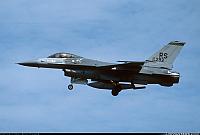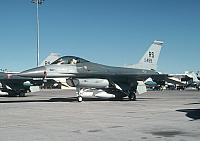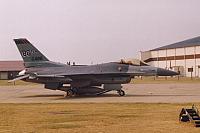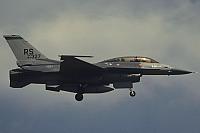 |
512th Fighter Squadron ( USAFE)" Dragons" |
 |
512 FS " Dragons" ( USAFE) | |||
| Status: |
Disbanded
|
|||
| Version: | F-16C/D block 40 | |||
| Role: | Attack, Strike | |||
| Tailband: | Green & Black | |||
| Motto: | Vigilare Pro Pace (Look Out for Peace). | |||
| Badge: | N/A | |||
|
Disbanded on October 1st, 1994.
|
||||
F-16 History
The first squadron of the 86th TFW to receive the brand-new F-16 fighters was the 512th TFS. Delivery of block 25 airframes already started in late 1985, but progress was very slow. In 1986 the decision was taken to re-equip the squadron with block 30 airframes. They started to arrive in early 1987 and the full complement was delivered before year-end. All the block 25 airframes were transferred to the 50th TFS at Hahn AFB to speed up re-equipment there as well.
The squadron’s role was conventional air-to-ground by day and night. Secondly the squadron continued the nuclear strike role it had inherited since the F-4 era. Ramstein AB would eventually be the largest concentration of US nuclear devices on mainland Europe and remains this way up till today (2011).
After the end of the Cold War the USAF had a major overcapacity of fighter units in Europe. The squadron avoided the axe and stayed for a short while. Rhein-Main AB was slated for closure and its airlift capacity needed to be preserved. Therefore it was to be moved to Ramstein AB and the units there needed to move.
Even when the squadron was slated for disbandment, they started receiving brand-new block 40 airframes capable of using the LANTIRN system. In the end only a few of those airframes ended up with the squadron before it was disbanded on October 1st, 1994. The squadron’s personnel was moved to Aviano AB in Italy to form the 510th FS under the control of a newly formed 31st FW.

Aircraft Markings History
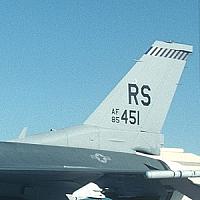
On top of the tail was a green and black sliced tailband. In the center the tailcode 'RS' - meaning Ramstein - with the serial underneath. On some tails a dragon was placed below the tailband and the tailband itself was in toned down markings.
Unit History
- 1943: Activation of the squadron in Key Field, Mississippi (as 628 BS)
- 1943: A-20 'Havoc' (part of 406 BG)
- 1943: A-24 'Banshee'
- 1943: A-26 'Invader'
- 1943: A-26 'Invader' (redesignated 512 FBS)
- 1943: P-39 'Airacobra' (Congaree AAF, South Carolina)
- 1943: P-40 'Warhawk'
- 1943: P-47 'Thunderbolt II'
- 1944: P-47 'Thunderbolt II' (Ashford [Eng.])
- 1944: P-47 'Thunderbolt II' (Tour-en-Bassin [Fr.])
- 1944: P-47 'Thunderbolt II' (Cretteville [Fr.])
- 1944: P-47 'Thunderbolt II' (St. Leonard [Fr.])
- 1944: P-47 'Thunderbolt II' (Mourmelon [Fr.])
- 1945: P-47 'Thunderbolt II' (Prosnes [Fr.])
- 1945: P-47 'Thunderbolt II' (Metz [Fr.])
- 1945: P-47 'Thunderbolt II' (As [Bel.])
- 1945: P-47 'Thunderbolt II' (Handorf [Ger.])
- 1945: P-47 'Thunderbolt II' (Nordholz [Ger.])
- 1946: Disbanded
- 1952: Activation of the squadron in Manston (England)
- 1952: F-84 'Thunderjet' (part of 406 FBG)
- 1953: F-86 'Sabre'
- 1954: F-86 'Sabre' (Soesterberg AB, [Neth.])
- 1955: F-86 'Sabre' (Bentwaters [Eng.])
- 1956: F-86 'Sabre' (part of 406 FIW)
- 1958: F-86 'Sabre' (part of 86 FIW, Sembach AB [Germ.])
- 1959: Disbanded
- 1975: Activation of the squadron in Ramstein (Germany)
- 1975: F-4E 'Phantom II' (part of 86 TFW)
- 1985: F-16C/D 'Fighting Falcon'
- 1992: F-16C/D 'Fighting Falcon' (part of 86 FW)
- 1994: Disbanded
F-16 Airframe Inventory
- All 512 FS F-16s in our F-16 Aircraft Database (past and current aircraft)
- Current 512 FS F-16s in our F-16 Aircraft Database
Photos
Please use this form to add any list any error or omissions you find in the above text.
Note: your comments will be displayed immediately on this page. If you wish to send a private comment to the webmasters, please use the Contact Us link.



